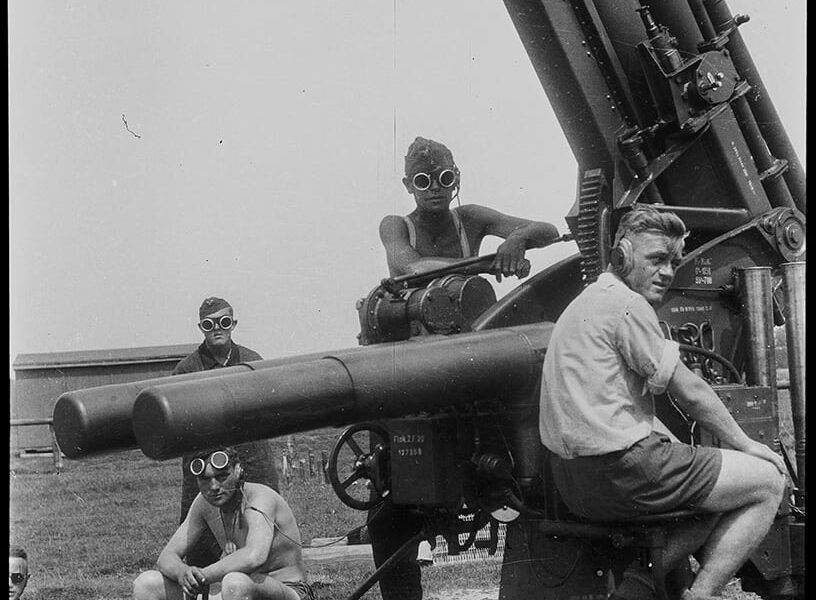
The negative archive of a German soldier serving in the anti-aircraft division consisted of 42 black-and-white negatives measuring 6 x 9 cm in a yellowed Agfa paper envelope. This envelope was handed over on September 28, 1941, at the Heinz Gufler photo studio in Wieden (Baden-Württemberg) to a customer named Scherll, who was most likely the author of the photographs. Most of the photographs depict the life and service of the Third Reich’s anti-aircraft gunners, who were considered the elite of the German armed forces.
The Flak 37 anti-aircraft unit, a heavy 88 mm Flak 37, in which the photographer served, was located on Germany’s western defense line, the so-called “Westwall.” One of the photographs shows the flak being transported to its location by an Sd.Kfz. 7 heavy artillery vehicle, which was specially designed to transport such guns. The photographer’s flak battery was in stationary positions in the field, so the photos sometimes show soldiers milking cows or harvesting potatoes. Children and civilians who wanted to see the legendary German gun were frequent visitors to the flak gunners. On top of the gun is the white inscription “Dora,” a German woman’s nickname for this gun. The gun worked in conjunction with the anti-aircraft artillery’s acoustic guidance system to precisely determine target, range, direction, and elevation. This system can also be seen in the photographer’s images. The highlight of this archive is the footage of anti-aircraft fire on enemy bombers during a night raid. These images look quite spectacular.
When we talk about the air battles of World War II, we primarily remember the flying aces, the dogfights between enemy fighters, and the bombers and their attacks on German territory. However, we forget to mention the importance of German air defense and anti-aircraft defense, which represented the main weapon against the bombers.
The first stationary German air defense emplacements were part of the “Westwall,” which involved the creation of a Western Air Defense Zone (LVZ-West) stretching from the Eifel region south through Saarland along the Moselle River to the Black Forest and the Swiss border. The “Westwall” emplacements contained about a third of all the heavy anti-aircraft batteries the Germans possessed at the start of the war, including the photographer’s battery. The first line of defense consisted of 20 mm and 37 mm guns, followed by a second line of heavy 88 mm guns. However, the Luftwaffe was well aware that there would never be enough anti-aircraft guns to cover all possible targets. Therefore, the heavy 88 mm anti-aircraft guns were designed to be mobile and could be transported by heavy trucks (as in the archival photo).
From 1940 to 1945, Germany was subjected to the most intensive air attack in history. Around 2 million tons of bombs were dropped. The most important weapon against the enemy bombers was the anti-aircraft troops.
Due to the use of German anti-aircraft gunners, the life expectancy of an Allied bomber in 1943 was only 40 hours. But destroying an aircraft was not the only benefit of anti-aircraft guns. Bombers had to maneuver to avoid anti-aircraft fire, drastically reducing their accuracy. According to several studies, evasive maneuvers resulted in only 48% of bombs falling within 5 km of their target. Some pilots dropped their bombs prematurely to avoid collisions with anti-aircraft guns. Others suffered severe post-traumatic or psychological disorders caused by the fear of flying under anti-aircraft fire. Such pilots were called “Flak Happy.” Overall, anti-aircraft batteries shot down more aircraft than fighters.
In 1944, nearly one million tons of bombs were dropped on Germany from the air—a wartime record (in 1943, the figure had been just over 200,000 tons). By this time, the Luftwaffe’s fighter pilots were already scattered, and Germany’s only defense against the bombers was its anti-aircraft forces. But even these were not in the best shape. Most of the able-bodied men who remained in the anti-aircraft units were transferred to Flak-Sturm batteries, which became purely ground-attack units. In 1944, hundreds of anti-aircraft batteries, along with the remaining Luftwaffe personnel, were transferred to the Eastern Front. And while the anti-aircraft gunners had previously survived the daily bombardments of Germany, they now faced the harsh reality of ground combat. Gradually, the German anti-aircraft forces, which had once been a model for the world, transformed into an army of postal workers, factory workers, prisoners, women, and children.
On April 25, 1945, the U.S. 8th Air Force conducted its last major raid. B-17 bombers hit the Skoda weapons factory, and B-24 bombers struck railway depots near Berchtesgaden. Although no German fighters took off, the anti-aircraft fire was heavy, damaging 200 American bombers. It is therefore safe to assume that German anti-aircraft gunners defended German airspace until the final days of the war.
View as story View as gallery

Parkstein is a church located on the basalt cone Hoher Parkstein. Parkstein, also called Hoher Parkstein and Basaltkegel, is a well-known mountain and tourist destination in the Steinwald Mountains in Central Germany. It is located 10 kilometers northwest of Weiden in der Oberpfalz in the Neustadt ad Waldnab district in northern Upper Palatinate. Germany, Bavaria. 1936-37
Parkstein is a church located on the basalt cone Hoher Parkstein. Parkstein, also called Hoher Parkstein and Basaltkegel, is a well-known mountain and tourist destination in the Steinwald Mountains in Central Germany. It is located 10 kilometers northwest of Weiden in der Oberpfalz in the Neustadt ad Waldnab district in northern Upper Palatinate. Germany, Bavaria. 1936-37
More about the photo

Two German couples at a train station. Bavaria, Germany. 1936-37
Two German couples at a train station. Bavaria, Germany. 1936-37
More about the photo

German anti-aircraft gunners celebrate their graduation. In the background, lockers, beds, and a poster with aircraft silhouettes for quick identification in the sky are visible. Germany. 1940-41
German anti-aircraft gunners celebrate their graduation. In the background, lockers, beds, and a poster with aircraft silhouettes for quick identification in the sky are visible. Germany. 1940-41
More about the photo

German 11-ton Sd.Kfz. 7 artillery tractor, designed to tow heavy artillery pieces. An 88 mm FlaK 37 gun is attached to the rear. West Germany. 1940-41
German 11-ton Sd.Kfz. 7 artillery tractor, designed to tow heavy artillery pieces. An 88 mm FlaK 37 gun is attached to the rear. West Germany. 1940-41
More about the photo

Building structures and fortifications at the 88-mm Flak 37 positions. West Germany. 1940-41
Building structures and fortifications at the 88-mm Flak 37 positions. West Germany. 1940-41
More about the photo

Building structures and fortifications at the 88-mm Flak 37 positions. West Germany. 1940-41
Building structures and fortifications at the 88-mm Flak 37 positions. West Germany. 1940-41
More about the photo

Portrait of a German anti-aircraft gunner. West Germany. 1940-41
Portrait of a German anti-aircraft gunner. West Germany. 1940-41
More about the photo

German anti-aircraft gunners set up a tent at their new location. An 88mm FlaK 37 can be seen in the background. West Germany. 1940-41
German anti-aircraft gunners set up a tent at their new location. An 88mm FlaK 37 can be seen in the background. West Germany. 1940-41
More about the photo

A German soldier wearing headphones and sunglasses works with an 88 mm Flak 37. The weapon is nicknamed Dora. West Germany. 1940–1941
A German soldier wearing headphones and sunglasses works with an 88 mm Flak 37. The weapon is nicknamed Dora. West Germany. 1940–1941
More about the photo

A German soldier wears headphones while operating an 8.8 cm FlaK 37 (also known as the “Acht-Acht”), a German 8.8 cm anti-aircraft gun in service with the German Air Defense Force. West Germany. 1940-41
A German soldier wears headphones while operating an 8.8 cm FlaK 37 (also known as the “Acht-Acht”), a German 8.8 cm anti-aircraft gun in service with the German Air Defense Force. West Germany. 1940-41
More about the photo

Acoustic guidance system for anti-aircraft artillery. An acoustic locator consisting of four acoustic horns, a horizontal pair and a vertical pair, connected via rubber tubes to stethoscope headphones worn by two technicians on the left and right. The stereo headphones allowed one technician to determine the direction and the other the altitude of the aircraft. The acoustic locator could locate targets at a distance of 5 to 12 kilometers, depending on weather conditions, operator skill, and the size of the target formation. Directional accuracy was approximately 2 degrees. West Germany. 1940–41
Acoustic guidance system for anti-aircraft artillery. An acoustic locator consisting of four acoustic horns, a horizontal pair and a vertical pair, connected via rubber tubes to stethoscope headphones worn by two technicians on the left and right. The stereo headphones allowed one technician to determine the direction and the other the altitude of the aircraft. The acoustic locator could locate targets at a distance of 5 to 12 kilometers, depending on weather conditions, operator skill, and the size of the target formation. Directional accuracy was approximately 2 degrees. West Germany. 1940–41
More about the photo

German anti-aircraft gunners prepare grenades. The anti-aircraft gunner on the left adjusts the delay on the nose fuse with a special hand wrench. West Germany. 1940-41
German anti-aircraft gunners prepare grenades. The anti-aircraft gunner on the left adjusts the delay on the nose fuse with a special hand wrench. West Germany. 1940-41
More about the photo

A German anti-aircraft gunner adjusts the delay on a grenade’s nose fuse with a special hand wrench. West Germany. 1940-41
A German anti-aircraft gunner adjusts the delay on a grenade’s nose fuse with a special hand wrench. West Germany. 1940-41
More about the photo

German anti-aircraft gunners load an 88 mm FlaK 37. West Germany. 1940-41
German anti-aircraft gunners load an 88 mm FlaK 37. West Germany. 1940-41
More about the photo

German anti-aircraft gunners load an 88 mm FlaK 37. West Germany. 1940-41
German anti-aircraft gunners load an 88 mm FlaK 37. West Germany. 1940-41
More about the photo

German anti-aircraft gunners load an 88 mm FlaK 37. West Germany. 1940-41
German anti-aircraft gunners load an 88 mm FlaK 37. West Germany. 1940-41
More about the photo

German anti-aircraft gunners take food from soldiers’ kettles while sitting next to an 88mm FlaK 37. West Germany. 1940-41
German anti-aircraft gunners take food from soldiers’ kettles while sitting next to an 88mm FlaK 37. West Germany. 1940-41
More about the photo

A German postman delivers field mail to the position of German anti-aircraft guns. West Germany. 1940-41
A German postman delivers field mail to the position of German anti-aircraft guns. West Germany. 1940-41
More about the photo

German anti-aircraft gunners at work with an 88 mm Flak 37. West Germany. 1940-41
German anti-aircraft gunners at work with an 88 mm Flak 37. West Germany. 1940-41
More about the photo

German anti-aircraft gunners rest next to an 88mm Flak 37. West Germany. 1940-41
German anti-aircraft gunners rest next to an 88mm Flak 37. West Germany. 1940-41
More about the photo

A German anti-aircraft gunner next to an 88 mm Flak 37. West Germany. 1940-41
A German anti-aircraft gunner next to an 88 mm Flak 37. West Germany. 1940-41
More about the photo

German anti-aircraft gunners at work with an 88 mm Flak 37. West Germany. 1940-41
German anti-aircraft gunners at work with an 88 mm Flak 37. West Germany. 1940-41
More about the photo

German anti-aircraft gunners near an 88-mm FlaK 37. West Germany. 1940-41
German anti-aircraft gunners near an 88-mm FlaK 37. West Germany. 1940-41
More about the photo

German anti-aircraft gunners on an 88 mm FlaK 37. West Germany. 1940-41
German anti-aircraft gunners on an 88 mm FlaK 37. West Germany. 1940-41
More about the photo

German anti-aircraft gunners in a field position cleaning their boots. West Germany. 1940-41
German anti-aircraft gunners in a field position cleaning their boots. West Germany. 1940-41
More about the photo

German anti-aircraft gunners help a girl harvest potatoes in a field near their position. West Germany. 1940-41
German anti-aircraft gunners help a girl harvest potatoes in a field near their position. West Germany. 1940-41
More about the photo

German anti-aircraft gunners milk a cow in a field near their position. West Germany. 1940-41
German anti-aircraft gunners milk a cow in a field near their position. West Germany. 1940-41
More about the photo

German anti-aircraft gunners milk a cow in a pasture near their position. An 88mm FlaK 37 can be seen in the background. West Germany. 1940-41
German anti-aircraft gunners milk a cow in a pasture near their position. An 88mm FlaK 37 can be seen in the background. West Germany. 1940-41
More about the photo

German anti-aircraft gunners take food from soldiers’ kettles while sitting next to an 88mm FlaK 37. West Germany. 1940-41
German anti-aircraft gunners take food from soldiers’ kettles while sitting next to an 88mm FlaK 37. West Germany. 1940-41
More about the photo

German anti-aircraft gunners with children and civilians near an 88 mm FlaK 37 gun. Many children helped the German air defense forces; they were called Flakhelfer (flak helpers). Germany relied on child soldiers to bolster the Reich’s air defense. The children of the anti-aircraft batteries, some as young as 16, actively participated in the war. They served in all types of anti-aircraft batteries under the guidance of Luftwaffe veterans who were too old or too frail for combat duty. Flakhelfer served only in batteries within Germany. West Germany. 1940–1941
German anti-aircraft gunners with children and civilians near an 88 mm FlaK 37 gun. Many children helped the German air defense forces; they were called Flakhelfer (flak helpers). Germany relied on child soldiers to bolster the Reich’s air defense. The children of the anti-aircraft batteries, some as young as 16, actively participated in the war. They served in all types of anti-aircraft batteries under the guidance of Luftwaffe veterans who were too old or too frail for combat duty. Flakhelfer served only in batteries within Germany. West Germany. 1940–1941
More about the photo

German anti-aircraft gunners with children and civilians near an 88 mm FlaK 37 gun. Many children helped the German air defense forces; they were called Flakhelfer (flak helpers). Germany relied on child soldiers to bolster the Reich’s air defense. The children of the anti-aircraft batteries, some as young as 16, actively participated in the war. They served in all types of anti-aircraft batteries under the guidance of Luftwaffe veterans who were too old or too frail for combat duty. Flakhelfer served only in batteries within Germany. West Germany. 1940–1941
German anti-aircraft gunners with children and civilians near an 88 mm FlaK 37 gun. Many children helped the German air defense forces; they were called Flakhelfer (flak helpers). Germany relied on child soldiers to bolster the Reich’s air defense. The children of the anti-aircraft batteries, some as young as 16, actively participated in the war. They served in all types of anti-aircraft batteries under the guidance of Luftwaffe veterans who were too old or too frail for combat duty. Flakhelfer served only in batteries within Germany. West Germany. 1940–1941
More about the photo

Portrait of a German anti-aircraft gunner next to an 88mm Flak 37. West Germany. 1940-41
Portrait of a German anti-aircraft gunner next to an 88mm Flak 37. West Germany. 1940-41
More about the photo

German anti-aircraft gunners operate an 88 mm FlaK 37. West Germany. 1940-41.
German anti-aircraft gunners operate an 88 mm FlaK 37. West Germany. 1940-41.
More about the photo

German anti-aircraft gunners operate an 88 mm FlaK 37. West Germany. 1940-41.
German anti-aircraft gunners operate an 88 mm FlaK 37. West Germany. 1940-41.
More about the photo

A German anti-aircraft gunner cleans the optics of an 88 mm Flak ZF 20 Flak 37. West Germany. 1940-41
A German anti-aircraft gunner cleans the optics of an 88 mm Flak ZF 20 Flak 37. West Germany. 1940-41
More about the photo

A battery of 88-mm anti-aircraft guns in action with night bombers over the Reich. West Germany. 1940-41
A battery of 88-mm anti-aircraft guns in action with night bombers over the Reich. West Germany. 1940-41
More about the photo

A battery of 88-mm anti-aircraft guns in action with night bombers over the Reich. West Germany. 1940-41
A battery of 88-mm anti-aircraft guns in action with night bombers over the Reich. West Germany. 1940-41
More about the photo

A battery of 88-mm anti-aircraft guns in action with night bombers over the Reich. West Germany. 1940-41
A battery of 88-mm anti-aircraft guns in action with night bombers over the Reich. West Germany. 1940-41
More about the photo

A battery of 88-mm anti-aircraft guns in action with night bombers over the Reich. West Germany. 1940-41
A battery of 88-mm anti-aircraft guns in action with night bombers over the Reich. West Germany. 1940-41
More about the photo

A battery of 88-mm anti-aircraft guns in action with night bombers over the Reich. West Germany. 1940-41
A battery of 88-mm anti-aircraft guns in action with night bombers over the Reich. West Germany. 1940-41
More about the photo

A battery of 88-mm anti-aircraft guns in action with night bombers over the Reich. West Germany. 1940-41
A battery of 88-mm anti-aircraft guns in action with night bombers over the Reich. West Germany. 1940-41
More about the photo











